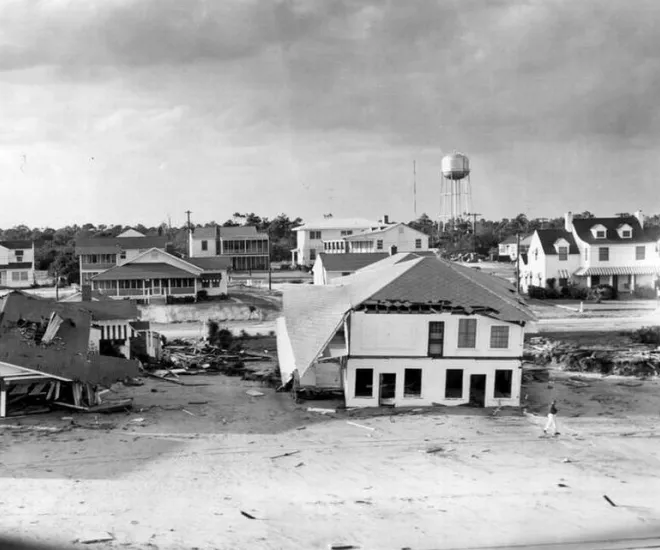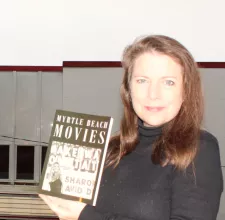70th Anniversary of Myrtle Beach’s Coming of Age

1954 and what it means to Myrtle Beach
If you had to pick one year to signify Myrtle Beach’s coming of age, 1954 would be a good one to choose. 2024 will mark the 70th anniversary of Myrtle Beach’s transformation from a small coastal town to what was going to be the world-class vacation destination that it is today. In ’54, several significant things happened that really put Myrtle Beach on the map, and one that nearly wiped it off the map completely.
Hurricane Hazel
On October 15th, 1954, Myrtle Beach was hit by Hurricane Hazel. It came in on a high tide under a full moon. It doesn’t get much worse than that. To this day, that category four storm is the worst natural disaster Myrtle Beach has ever had to deal with.
Before Hazel, our shore was lined, for the most part, with wooden beach cottages and guest houses. There were so many guest houses by 1951, that a Boulevard Accommodation Association was formed. They held regular meetings that were attended almost 100% by women. For the first fifty years of Myrtle Beach’s history, it was ladies who primarily took care of our visitors.
What would often happen was that a family would have a farm somewhere else in the county, usually around our county seat of Conway. In the summer, the men and the boys would work the fields as they always did. And the women and girls would come over to the beach and run the guest houses. Thereby, the family could double their income during the tourist season that would last three months, at best.
Many of those guest houses were washed away in 1954. Hurricane Hazel literally and figuratively cleared the slate for the oceanfront development that we know today. Today’s high-rises were preceded by mid-century modern motels built after Hazel, some of which are still in use. Two, now referred to as doo-wops by architectural historians, have been brought back to their former glory in recent years. They are the Holiday Shores and the Waikiki Village Retro Motel. Book a room at one if you would like an upscale retro accommodation experience.
The Myrtle Beach Air Force Base
After WWII, the Myrtle Beach [United States] Army Air Corps Airfield was closed by the federal government and the property was given back to the city. That land now includes The Market Common. It is not only the area’s premiere shopping, dining, and entertainment destination, it has become the home to some family traditions for both locals and visitors.
In the spring and fall they host the Taste of The Market Common where participants buy tickets to sample fare from most of the wonderful restaurants there and then vote on their favorite dishes. On October 31st, there is the Hometown Halloween where at least 1000 costumed attendees of every generation gather to trick-or-treat in the picturesque lifestyle center and the little ones enjoy a DJ’d Monster Mash. The traditions really kick in during the holidays with the annual tree lighting, carriage rides and many opportunities for both humans and pets to get photographed with Santa. The season culminates with A Southern Times Square where thousands of revelers enjoy a fantastic New Year’s Eve celebration complete with live music and a ball-drop.
Between those two eras, from the Cold War to Desert Storm, that area adjacent to the Myrtle Beach International Airport was the Myrtle Beach Air Force Base. On April Fools’ Day in 1954, the Town of Myrtle Beach handed over that property to the federal government in order for them to create the base. Since the post-war closure of the airfield, the land had been used for the municipal airport, a travelodge, three turkey farms boasting 50,000 turkeys, and a baseball spring training camp for the farm team of the Boston Braves.
Having the base in Myrtle Beach until 1993 was a boost to the local economy with the increased population of active military and their families along with retired military who came here to enjoy our exceptional location and the amenities on the base. It was considered one of the most popular places to be stationed in the Air Force. On Friday afternoons, there would be an influx of small military aircraft that were basically the equivalent to corporate jets that would fly in the top brass from Washington, DC, and elsewhere to play a round or two of golf on the base’s course, Whispering Pines, now owned by the City of Myrtle Beach.
Coastal Carolina University
What is now CCU, Coastal Carolina University, affectionately known as Teal Nation (after its unique school color) and is becoming known for its spirited cheer, Chants Up!, was founded in 1954. The cheer is based on its mascot, a chanticleer. For those of you learning all of this for the first time, my explanation may be less clear. Let me explain further. In the past, CCU was part of the University of South Carolina whose mascot is the gamecock. A chanticleer is basically a rooster. So the local campus adopted this adaptation of the USC symbol as their own and kept it when they became the CCU we know today.
Now that you are up to speed, let’s take you to the next level. There’s a hand gesture that you use when yelling Chants Up!. You hold your fingers in such a way to represent a rooster’s head. Press your forefinger to your thumb and curve them a bit to represent the beak. Then hold the three remaining fingers up at increasing heights to look like the rooster’s comb. You can see a demonstration on this page.
The symbol’s popularity really didn’t take off until 2012. Prior to that time, CCU wasn’t particularly known for its athletic program, but in 2016, that all changed. On June 19th of that year, CCU golf team alumnus, Dustin Johnson, won his first major, the US Open. On June 30th, the Chanticleer baseball team won the national championship. Dustin won his second major, The Masters, in November of 2020. That was at the same time that the Chanticleer football team went from last place in their conference, had a stellar undefeated season, and went to their first bowl game. Their then coach, Jamey Chadwell, was selected by the Associated Press and a whole slew of similar organizations as the best college football coach in the whole country. The team has been going to bowl games each season ever since.
Sports Illustrated Magazine
Pine Lakes International Country Club is called “The Granddaddy” because it was the Grand Strand’s first golf course. But its claim to fame is that it is the birthplace of Sports Illustrated magazine. To be clear, Sports Illustrated wasn’t conceived at Pine Lakes, but it was birthed there in a manner of speaking. The magazine hit the newsstands for the first time in August of 1954. In April of that year, 67 publishing executives from TIME in New York came down to spend a week at Pine Lakes for a marketing conference. They played golf and held meetings to determine how they were going to launch this weird new magazine. Whose ever heard of a magazine only about sports? Would it last? Well, apparently, Pine Lakes did well by them because Sports Illustrated celebrates its 70th year in 2024. When you visit the course and enter the clubhouse via the pro shop, you will see outside and to the right of the steps leading up to the door a bronze plaque commemorating the 50th anniversary of that popular publication.
